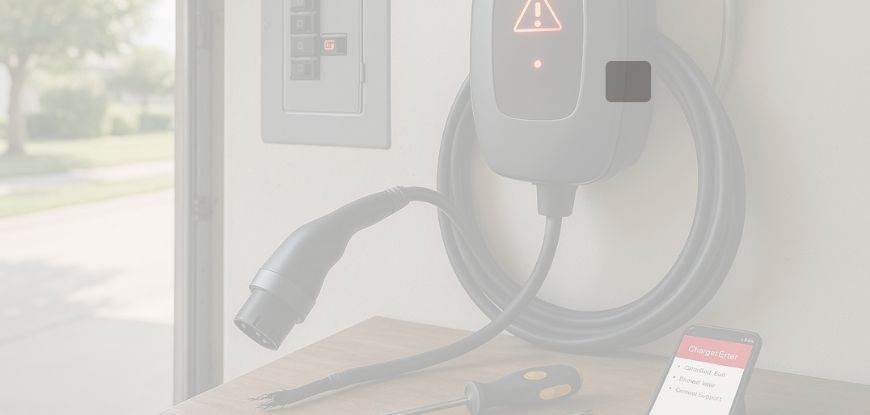One of the biggest decisions when thinking about installing an EV charger at home is where to actually install it: indoors in your garage or outdoors on an exterior wall. While both options can be effective, the right choice depends on your home layout, parking habits, and local climate.
There are many pros and cons of outdoor vs. indoor EV charger installation, with key considerations like weatherproofing, cable management, aesthetics, and electrician recommendations, to help you make the best decision for your home and your EV.
Indoor EV Charger Installation (Garage)
✅ Pros
- Protection from the Elements
Indoor installations are naturally shielded from rain, snow, UV rays, and extreme temperatures. This helps prolong the lifespan of your charger and reduces the risk of corrosion or water damage. - Clean Aesthetic and Easy Cable Storage
Mounting a charger inside the garage keeps it out of sight from the street, and many garages allow for neat cable coiling and storage. - Enhanced Security
With the charger behind a closed garage door, there's no concern about theft or unauthorized access. - Stable Charging Environment
Indoor spaces generally have more stable temperatures, which may be better for battery charging and charger efficiency in very hot or cold climates.
❌ Cons
- Limited to Garage Parking
If you don't consistently park in your garage, or your garage is used for storage or other purposes, accessing the charger can become inconvenient. - May Require Longer Cable Runs
If your main electrical panel is on the opposite side of your house from the garage, installing the charger there could involve a longer wire run and higher labor costs. - Space Constraints
Tight garages might make installation more complicated, especially if there’s limited wall space or if vehicles barely fit.
Outdoor EV Charger Installation (Exterior Wall)
✅ Pros
- Convenient for Driveway or Carport Parking
If you always park outside or don’t use your garage, outdoor installation offers easy access right where your car is most often parked. - Flexibility in Location
Electricians can mount outdoor EV chargers in more places, including side yards or detached garages, giving you flexibility if your garage isn’t ideal. - Faster Installation (in Some Cases)
If your main electrical panel is already located on an exterior wall near your driveway, outdoor installation may require shorter cable runs, reducing installation time and cost.
❌ Cons
- Exposure to Weather and Temperature Extremes
While most EV chargers (like the Tesla Wall Connector) are rated for outdoor use and weather-resistant, ongoing exposure to rain, snow, and sun may affect long-term durability. - Security Concerns
Chargers installed outdoors are more visible and potentially more accessible to theft or tampering, though most require authorization to use. - Aesthetic Impact
An EV charger mounted to the front or side of your home may not be visually appealing and could affect your home’s exterior appearance. - Additional Code Requirements
Outdoor installations may require extra weatherproofing, conduit protection, and GFCI breakers to comply with electrical codes, adding complexity to the project.
Other Key Considerations
Cable Length and Accessibility
No matter where you install your charger, you’ll want to make sure the charging cable easily reaches your vehicle's charging port. Measure your typical parking distance from the charger location before installation. Tesla Wall Connectors come with an 18- or 24-foot cable, enough for most garages and driveways.
Electrician Recommendations
Most licensed electricians will start your EV charger project with a site visit to determine the best location based on:
- Proximity to your electrical panel
- Load capacity and potential need for panel upgrades
- Permitting requirements
- Daily parking patterns and vehicle needs
If you're uncertain, ask us for a quote for both indoor and outdoor setups—you may be surprised which one ends up being more practical or cost-effective.
Cost Differences
Installation cost can vary depending on the location. Outdoor installs might cost slightly more due to weatherproofing materials and additional code compliance. However, indoor installs may become more expensive if they require long conduit runs or panel upgrades across the house.
So, Which Option Is Right for You?
Here’s a quick summary to help you decide:
|
Factor |
Indoor |
Outdoor |
|
Weather Protection |
✅ Excellent |
⚠️ Must be weather-rated |
|
Security |
✅ Protected |
⚠️ More vulnerable |
|
Aesthetics |
✅ Hidden |
⚠️ Visible from outside |
|
Installation Cost |
⚠️ Depends on layout |
⚠️ May require GFCI/weatherproofing |
|
Convenience |
✅ If you park in the garage |
✅ If you park outside |
|
Permits/Code |
Standard |
May require extras |
Both indoor and outdoor EV charger installations can be safe and efficient as long as they’re done by a licensed electrician. The best choice for your home depends on how and where you park, the location of your electrical panel, and your climate.
Before making a decision, contact us because we specialize in home EV charger installations. We can help you weigh the pros and cons specific to your property and ensure a code-compliant, future-ready setup that will keep your EV charged for years to come.
Need help deciding where to install your EV charger? Ask us for a professional site evaluation and quote to compare your options—and charge forward with confidence.

.jpg)


SHARE